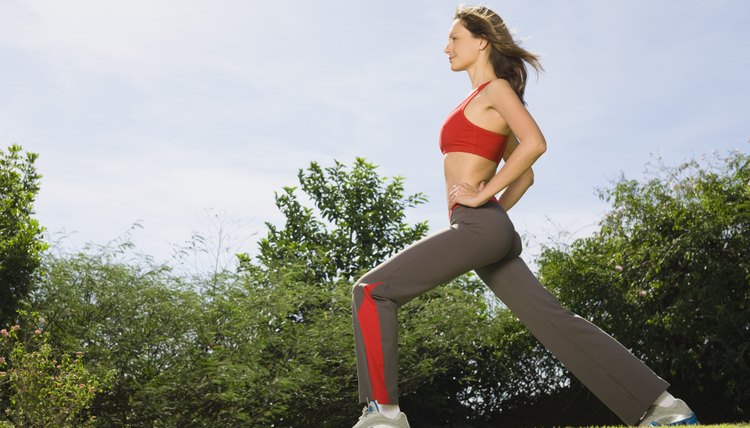What does fact checked mean?
At SportsRec, we strive to deliver objective content that is accurate and up-to-date. Our team periodically reviews articles in order to ensure content quality. The sources cited below consist of evidence from peer-reviewed journals, prominent medical organizations, academic associations, and government data.
The information contained on this site is for informational purposes only, and should not be used as a substitute for the advice of a professional health care provider. Please check with the appropriate physician regarding health questions and concerns. Although we strive to deliver accurate and up-to-date information, no guarantee to that effect is made.
Leg Extensions Vs. Lunges

Both leg extensions and lunges are common exercises used to strengthen the lower body. Extensions and lunges use two different kinds of movements and both provide advantages and disadvantages when weighed against each other. But incorporating both exercises into a lower body workout can benefit the lower body as a whole.
Movements
Strength training exercises can either be compound movements or isolation movements. Compound movements involve more than one joint and multiple muscle groups. Isolations involve the movement of only one joint and engage a single muscle group. Lunges are a compound movement involving flexion and extension of the hip, knee and ankle, activating the entire lower body musculature. Leg extensions are an isolation movement that target the quadriceps of the upper through extension of the knee alone.
Muscles Worked
Leg extensions work the single muscle group of the quadriceps. The quadriceps consist of four sections – the rectus femoris, vastus lateralis, vastus intermedius and vastus medialis – but the quadriceps are the only muscle activated during the full range of motion. Lunges also work the quadriceps but work the gluteus maximus – the muscles of your butt – the adductor magnus at the inner thigh (especially side lunges, initiated by stepping to the side), the hamstrings at the back of your upper leg and the muscles of the calf and shin as well. Reverse lunges target the glutes even more. Reverse lunges are initiated by stepping back instead of stepping forward.
Advantages
Lunges provide the advantage of working multiple muscles at once. Lunges also emulate a functional movement that you might use in your every day activities, strengthening the right muscles so you can lunge effectively to pick something up off the floor or to catch a ground ball. Lunges also activate smaller stabilizing muscles by challenging your stability and balance. Isolating the quadriceps through extensions can be beneficial as it ensures that the quadriceps work completely alone without relying on assistance from the other large muscles in the legs. Leg extensions are also an effective movement to help strengthen the connective tissue around the kneecap. Leg extensions focus work on the quadriceps tendon and also force the patellar tendon to activate against the resistive force of the movement.
Disadvantages
Lunges work multiple muscles at once but require a greater coordination and attention to form on account of the compound movement. Lunging with incorrect form can lead to tweaks and injuries in multiple joints. The element of instability can be an advantage but also a disadvantage if you’re not yet strong enough to stabilize your body in the lunge position. Lunging can also place a great deal of stress on the knees if performed incorrectly or if you’re lunging deeper than you’re ready for. Leg extensions are not a functional movement and, though they can build your quadriceps, they don’t necessarily teach them how to play with other muscles in your legs. Leg extensions have fewer adaptive weight increments for varying strengths. Lunges can be modified by limiting how deep you lunge or how far forward you step, but leg extensions can only be modified in five or ten-pound increments based on the machine’s weight stack.
References
- Human Anatomy and Physiology; Elaine N. Marieb
- ExRx.net: Lunge
Writer Bio
Jullie Chung writes regularly for various websites. She is a nationally certified fitness trainer and performance enhancement specialist through the National Academy of Sports Medicine and trains regularly in yoga, flatwater kayaking, boxing and mixed martial arts. An avid outdoor fan, she regularly hikes, climbs and trail runs.
